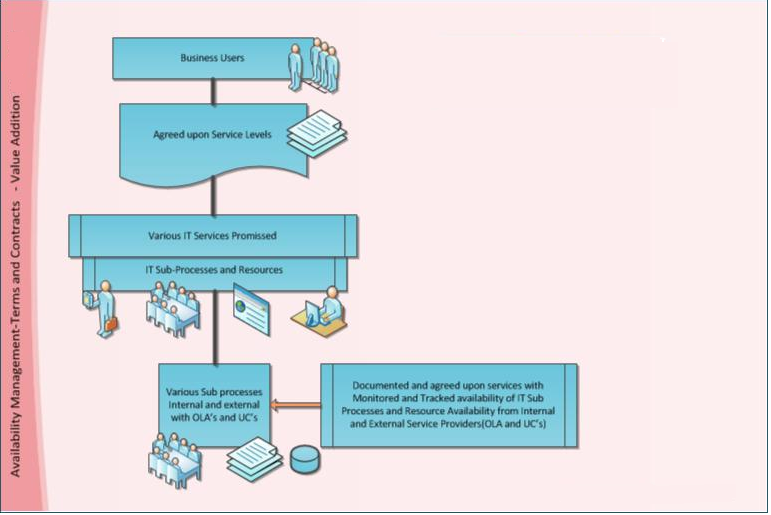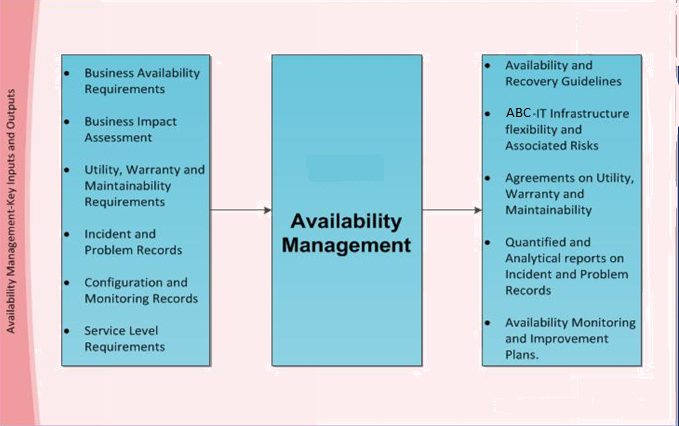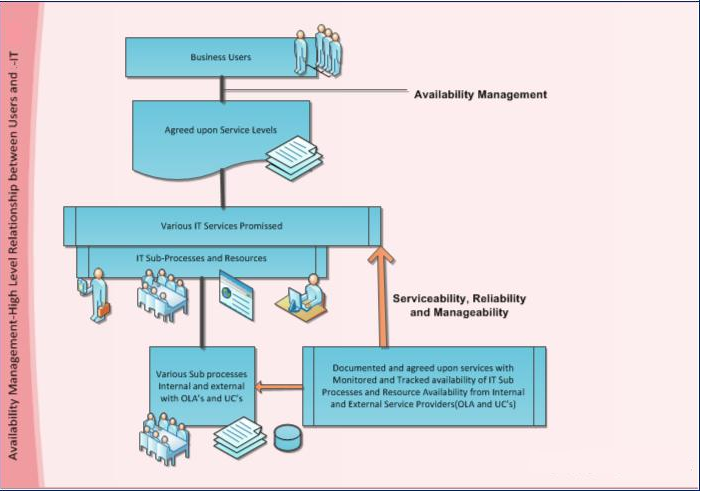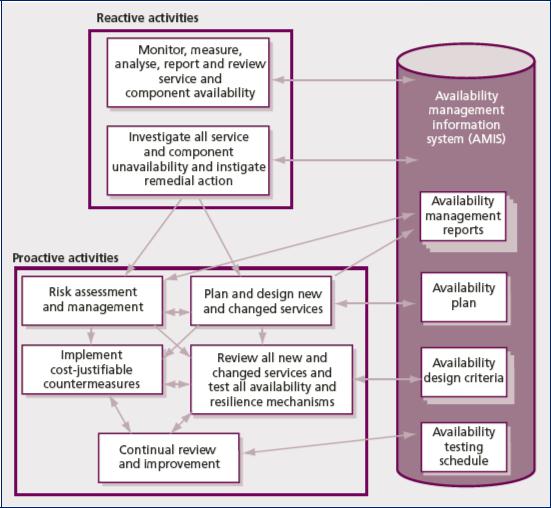The Availability management policy aims to understand specific requirements from the business and develop proactive and reactive measures to ensure that we make IT services available as per the business needs. We aim to minimize unavailability. [FII-SCF-003-BCD-10]
The Business value provided to Netspective Communications LLC LLC. And its users by following the Availability Management Process that meets expectation. The identified critical services are given priorities as per Business needs and hence, Value Addition.
Key Outcomes
- The process helps management make decisions by using a range of methods and techniques to forecast appropriate availability for known or expected business requirements, and determine if any changes are needed.
- The Availability Management process develops relevant information about what currently meets or fails Netspective Communications LLC LLC. requirements, studies the findings, and proposes enhancements and corrections within Netspective Communications LLC LLC.-IT, thus improving understanding of the IT infrastructure.
- The Availability Management process ensures regular communication and coordination between various related processes like Change Management, Capacity Management, Operations, and Continual Improvements, improving supplier communication. Netspective Communications LLC LLC.-IT vendors and contractual agreements also play a major role in providing added business value for Netspective Communications LLC LLC. as a whole.
- Provision of Availability Management processes, procedures, and tools helps the support teams at Netspective Communications LLC LLC.-IT ensure completion of technical recovery in an optimal time.

Process, Activities, Methods and Techniques
2.1. Availability Management Process
The scope of Availability Management includes designing, implementing, measuring, and managing IT Infrastructure Availability.
Netspective Communications LLC start the Availability Management process as soon as we can clearly articulate the availability requirements for an IT Service. It is an ongoing process that ends only when we decommission the IT Service.
Key Inputs
The key inputs to the Availability Management process include:
- The business’s availability requirements for new or enhanced Netspective Communications LLC LLC.-IT service(s).
- A business impact assessment for each vital business function that the Netspective Communications LLC LLC.-IT Infrastructure supports.
- The availability, reliability, and maintainability requirements for the Netspective Communications LLC LLC.-IT Infrastructure components that underpin the IT Service(s).
- Information on IT Service and component failure(s), usually recorded in the form of Incident and Problem records.
- A wide range of configuration and monitoring data related to each IT Service and component.
- Service level achievements against agreed targets for each IT Service that has an agreed SLA.
Key Outputs
The key outputs from the Availability Management process include:
- Availability and recovery design criteria for each new or enhanced Netspective Communications LLC LLC.-IT Service.
- Details of the Availability techniques that will be deployed to provide additional Infrastructure resilience to prevent or minimize the impact of component failure on the IT Service.
- Agreed targets for Availability, reliability, and maintainability for Netspective Communications LLC LLC.-IT Infrastructure components that underpin the IT Service(s).
- Availability reporting of Availability, reliability, and maintainability to reflect the business, user, and IT support organization perspectives.
- The monitoring requirements for IT components to ensure that deviations in Availability, reliability, and maintainability are detected and reported.
- Availability Plan for the proactive improvement of the Netspective Communications LLC LLC.-IT Infrastructure.
Availability Management: Key Activities
The key activities of the process are as follows:
- Determine the Availability requirements from the business for a new or enhanced Netspective Communications LLC LLC.-IT Service and formulate the Availability and recovery design criteria for the IT Infrastructure.
- Collaborate with the Configuration Management Process to determine the vital business functions and impact arising from IT component failure. If necessary, review the Availability design criteria to provide additional resilience to prevent or minimize impact to Netspective Communications LLC LLC. business.
- Define the targets for Availability, reliability and maintainability for Netspective Communications LLC LLC.-IT Infrastructure components that underpin the IT Services to document and agree within SLAs, OLAs and contracts.
- Establish measures and reporting of Availability, Reliability and Maintainability that reflect the business, User and Netspective Communications LLC LLC.-IT support organization perspectives.
- Monitor and analyze the trend of the Availability, Reliability and Maintainability of Netspective Communications LLC LLC.-IT components.
- Review IT Service and component Availability and identify unacceptable levels.
- Investigate the underlying reasons for unacceptable Availability.
- Produce and maintain an Availability Plan which prioritizes and plans IT Availability improvements.

Availability Management: Inter-Process Relationships**
The Availability Management Process is influenced by all IT Service Management Processes.
Therefore, all disciplines interface with Availability Management, with inputs being provided to it and outputs being dependent on it. The relationships between business users, Netspective Communications LLC LLC.-IT Services, and sub-processes are depicted in the diagram below:

Availability Management: Inter-process Relationships
| S. No. | Process | Relationship with Availability Management |
|---|---|---|
| 1 | Service Level Management | An input from Availability Management to the Service Level Management process is an assessment of the Availability that can be delivered for a new IT Service to enable the SLA to be negotiated and agreed. An output from Service Level Management to the Availability Management process is details of the agreed SLA that enables the appropriate Availability measurement and reporting to be instigated. |
| 2 | IT Service Continuity Management | An output from IT Service Continuity Management is a business impact assessment detailing the vital business functions dependent on IT Infrastructure Availability. An Input from Availability Management to IT Service Continuity Management is the Availability and recovery design criteria to maintain ‘business as usual’ by preventing or minimizing the impact of failures by use of techniques such as Component Failure Impact Assessment (CFIA). |
| 3 | IT Financial Management | An input from Availability Management to IT Financial Management is the Cost of non- Availability arising from the loss of an IT Service(s) to help cost justify improvements defined within the Availability Plan. An output from IT Financial Management to Availability Management is the costs associated with proposed upgrades to the IT Infrastructure to deliver increased levels of Availability |
| 4 | Capacity Management | An input from Availability Management to Capacity Management is a completed for a new IT Service denoting where Availability techniques are to be deployed to provide additional Infrastructure resilience. An output from Capacity Management to Availability Management is the Capacity Plan detailing how the Capacity requirements associated with the provision of additional Infrastructure resilience will be met. |
| 5 | Change Management | An input from Availability Management to Change Management is details of the planned maintenance regime, i.e. frequency, duration and impact, for components underpinning a new IT Service. An output from Change Management to Availability Management is a schedule of planned maintenance activities for IT components detailing the times and IT Services that will be impacted |
2.3. Determine Availability Requirements
The Netspective Communications LLC LLC.-IT organizations should analyze the Availability requirements of Netspective Communications LLC LLC.’s user base before accepting any Service level requirement and ultimately agreeing to the SLR or SLA. This analysis is essential to assess if and how the Netspective Communications LLC LLC.-IT Infrastructure can provide the required levels of Availability, not only for new IT Services but also for any requested Changes to the Availability requirements of existing Netspective Communications LLC LLC.-IT Services.
The business requirements for the Netspective Communications LLC LLC User base Availability Table should include a definition of the vital Business functions supported by the IT Service, a definition of Netspective Communications LLC LLC.-IT Service downtime, the conditions under which the business considers the IT Service to be unavailable, the business impact caused by the loss of service, quantitative Availability requirements indicating the extent to which the business tolerates IT Service downtime or degraded service, the required service hours, when the service is to be provided, an assessment of the relative importance of different working periods, and specific security requirements.
The Netspective Communications LLC LLC. - IT Service Catalog Module can provide a key input for the Availability Management process as it lists and categorizes all services based on their business value and availability requirements.
A broad view of Availability Management Review and analysis can be obtained from the table later in this section. Where-in, a high level analysis can be obtained on the Netspective Communications LLC LLC.-IT Services based on following factors:
- Service Description and Code
- Category
- Agreed Service Hours
- Actual Downtime Hours
Activity
PCII[companyName] LLC.-Management and Netspective Communications LLC LLC.-DevOps Manager should conduct a weekly/fortnightly review meeting on the high availability services to capture and bridge gaps between promised and delivered services. This will also aid in continually improving the Netspective Communications LLC LLC.-IT services and enhancing customer experience.
To improve service levels, simple methods such as a monthly survey or request-based survey (Point of Service Evaluation) can be implemented.
Availability Management: Quantification and Monitoring Approach
With guidance on Availability Management per ITIL norms, the following are the Netspective Communications LLC LLC.-IT services categorized at a broad level and their Business Utility for Netspective Communications LLC LLC. User base:
| S. No. | Service Code | Services | Category | Agreed Service Hours (Hrs.) | Actual Downtime (Hrs.) |
|---|---|---|---|---|---|
| 1 | SVC_0001 | Desktop & Laptop Support | Medium | ||
| 2 | SVC_0002 | Printing support services | Medium | ||
| 3 | SVC_0003 | Scanning support services | Low | ||
| 4 | SVC_0004 | Identity Management Services | High | ||
| 5 | SVC_0005 | Email support | Critical | ||
| 6 | SVC_0006 | Online Workspace(Share-point) | High | ||
| 7 | SVC_0007 | Video Conferencing(VC) | Medium | ||
| 8 | SVC_0008 | Online meeting | Medium | ||
| 9 | SVC_0009 | Mobile Communications(Smartphones, iPads) | Low | ||
| 10 | SVC_0010 | Standard Software | Medium | ||
| 11 | SVC_0011 | Freeware Software | Low | ||
| 12 | SVC_0012 | Licensed Software | Medium | ||
| 13 | SVC_0013 | Archiving | Low | ||
| 14 | SVC_0014 | Backups | Medium | ||
| 15 | SVC_0015 | Issuing License Support Services | Medium | ||
| 16 | SVC_0019 | Administrative and financial affairs | Medium | ||
| 17 | SVC_0020 | Human Resource (HR) | High | ||
| 18 | SVC_0021 | Contracts and tenders | High | ||
| 19 | SVC_0022 | Warehouses | Medium | ||
| 20 | SVC_0023 | Purchases |
2.4. Monitoring Of Service Availability
Availability Management should ensure that it provides the required level of Availability. To ensure that the Availability levels are being met consistently, it is crucial to measure and monitor Netspective Communications LLC LLC.-IT Services.
The respective Team/Manager needs to perform the following steps to identify the service components to be monitored for all the present and future set of services:
- Identify the critical components of the service based on the component level of Risk Assessment
- Define the availability criteria and threshold level of each of the component availability and Serviceability
- Define and implement monitoring on the component with suggested threshold limits, coordinate with respective departments, and track proactive/reactive activities to be performed by Support teams (Usually, the Service Desk monitors the critical HA components and Service Uptimes).
Also, identification of Component Level Monitoring and Monitoring Criteria is a key activity in this regard.
Reporting Criteria
We will describe some simple mathematics in this section that will enable us to calculate the component and total infrastructure availability. This information is necessary to formulate availability targets for IT components and services of Netspective Communications LLC LLC.
The calculations presented in the example provided in this section are fairly straightforward and are sufficient to provide adequate estimates of availability.
Basic Availability calculation
To determine the basic Availability of a given IT Service or component as an Availability percentage (%) the following basic formula can be used:

Where: - AST = Agreed service time; DT = Actual downtime during agreed service time.
Example
The IT Service had a planned downtime period of 2 hours per week for application maintenance, as well as an unplanned downtime of 3 hours due to an application software error.
To calculate the weekly Availability of the IT Service, the following steps were taken:
- The scheduled downtime of 2 hours per week was recognized by the AST.
- The unplanned downtime of 3 hours following the application maintenance was noted as DT.
- The AST value was calculated as 24 hours x 7 days - 2 hours = 166 hours per week.
- The DT value was calculated as 3 hours.
- The Availability calculation is: A = (166 - 3) / 166 x 100 = 98.78%.
Review of Reports and Methods
The IT Infrastructure, services, and supporting organization should continuously optimize the availability, to provide cost-effective improvements that deliver evidenced business and user benefits, and Availability Management should ensure this
Developing basic IT Availability measurement and reporting
At the Service level there are a number of metrics that should be defined, measured and reported providing a truly holistic view on how the Service meets the range of Availability criterion, e.g.: -
- Availability
- Reliability
Downtime Reporting
To provide information about the Availability or non-Availability of an IT component, organizations can consider using basic forms of measurement. For instance, they can report the total amount of time that a dependent IT service was unavailable as downtime. The downtime can be categorized as Unscheduled downtime (downtime caused by IT component failure), Planned downtime (downtime required for maintenance), and Extended downtime (the excess time required to complete planned maintenance).
If a Service Maintenance Objective (SMO) has been agreed upon for a planned maintenance activity, the total downtime incurred should be recorded as follows:
- Agreed SMO time: Planned downtime
- Total downtime incurred: Actual downtime
- Excess downtime: Extended downtime (Actual downtime - SMO time) By using this method of recording, organizations can differentiate between agreed planned downtime and the excess downtime that occurred due to implementation process deficiencies.
Extended downtime reporting can be utilized to review Change quality issues with internal and external suppliers and report them as non-compliance within the OLA and service contract reporting.
Incident Based Reporting
Incident reporting can be used to derive measures that reflect the overall reliability and maintainability of an IT Service and its supporting components. These measures can include:
- Frequency of failure: This measures the number of times a component failure occurred that impacted the IT Service within a given period or review cycle.
- Backup and Recovery Performance: This measures the time taken to recover from a component failure.
Incident-based reporting can produce data that indicates improving or deteriorating trends. The following measures can be derived from such reporting:
- MTBF (Mean Time Between Failures): This measures the average elapsed time from the time an IT Service or supporting component is fully restored until the next occurrence of a failure to the same service or component.
- MTBSI (Mean Time Between System Incidents): This measures the average elapsed time between the occurrence of one failure and the next failure.
- MTTR (Mean Time to Repair): This measures the average elapsed time from the occurrence of an Incident to the resolution of the Incident.

Critical Success Factors
Here are some generic Critical Success Factors for successfully implementing Availability Management at Netspective Communications LLC LLC.-IT:
- Manage the availability and reliability of Netspective Communications LLC LLC.-IT Services.
- Reduce the unavailability of services and components by a certain percentage.
- Increase the reliability of services and components by a certain percentage.
- Incorporate preventive maintenance in the Design phase.
- Meet business needs for access to Netspective Communications LLC LLC.-IT services.
- Reduce the unavailability of Netspective Communications LLC LLC.-services(VBF) by a certain percentage.
- Reduce the cost of business overtime due to unavailable Netspective Communications LLC LLC.-IT services by a certain percentage.
- Reduce critical time failures by a certain percentage. For example, plan for specific business peak and priority availability needs.
- Improve business and user satisfaction with the service by a certain percentage, as measured by a CSAT-Survey.
The Availability management team should closely collaborate with the Service Continuity Management teams, Information Security Management teams, and Capacity Management teams to produce justifications that secure the appropriate investment.
Reports and Meetings
We will produce meaningful reports that can be utilized to focus on areas that need improvement and use them in coordinated activities aimed at improving the support.
Availability Management: Implementation Methods
We can utilize a number of methods and techniques to identify Availability improvement opportunities. I will describe them as follows:
Component Failure Impact Assessment (CFIA)
We can use Component Failure Impact Assessment (CFIA) to predict and evaluate the impact on IT Service arising from component failures within the Netspective Communications LLC LLC.-IT Infrastructure. The output of a CFIA can help us identify where we should consider additional Infrastructure resilience to prevent or minimize the impact of component failure on the business operation and Users.
Fault Tree Analysis (FTA)
Fault Tree Analysis (FTA) is a technique that individuals can use to determine the chain of events that cause a disruption to IT Services. By using FTA in conjunction with calculation methods, they can create detailed models of Availability. These models can be utilized to assess the Availability improvement that can be achieved by individual IT Infrastructure design options. (Alternatively, individuals can use Fish Bone).
Systems Outage Analysis
The Availability Management team uses Systems Outage Analysis (SOA) to provide a structured approach for identifying the underlying causes of service interruption to the user. SOA assesses where and why shortfalls in Availability are occurring by utilizing a range of data sources.
SOA enables the team to take a holistic view to drive improvements not only to Netspective Communications LLC LLC.-IT Infrastructure but also to the IT support organization’s process, procedures, and tools.
The team runs SOA as an assignment and may utilize other Availability Management methods and techniques to formulate the recommendations for improvement.
Availability Plan
The Availability Management team should formulate a single Availability Plan to provide structure and aggregation of the wide range of initiatives that may need to be undertaken to improve Availability. The Availability Plan should have aims, objectives, and deliverables and should consider the wider issues of people, process, tools, and techniques as well as having a technology focus.
In the initial stages, the company should align the plan with an implementation plan for Availability Management.
As the Availability Management process matures, the company should evolve the plan to cover the following:
- Determine actual levels of Availability versus agreed levels of Availability for key Netspective Communications LLC LLC.-IT Services. The company should focus on measuring Availability as experienced by the business and User.
- Progress activities to address shortfalls in Availability for existing Netspective Communications LLC LLC.-IT Services. The company should include options with associated costs and benefits where investment decisions are required.
- Document changing Availability requirements for existing Netspective Communications LLC LLC.-IT Services. The plan should list the available options to meet these Changed requirements. The associated costs of each option should be included where investment decisions are required.
- Document the Availability requirements for forthcoming new Netspective Communications LLC LLC.-IT Services. The plan should list the available options to meet these new requirements. The associated costs of each option should be included where investment decisions are required.
During the production of the Availability Plan, we recommend liaising with the following functional areas:
- Contact Service Level Management for changing business and User requirements for existing Netspective Communications LLC LLC.-IT Services
- Contact IT Service Continuity Management for business impact and resilience improvements
- Contact Business Relationship Management to understand major Customer concerns and/or future needs that relate to Netspective Communications LLC LLC.-IT Services Availability
- Contact Capacity Management for scenarios for upgrading (or downgrading) the software, hardware, and network layers of the Netspective Communications LLC LLC.-IT Infrastructure
- Contact IT Financial Management for the cost and budget implications of the various options identified for Availability improvement
- Contact Application Management for Availability requirements for new services
- Contact areas responsible for IT supplier management and managing relationships and contracts with suppliers.
Technical support groups responsible for testing and maintenance functions should address the reliability and maintainability of existing services.